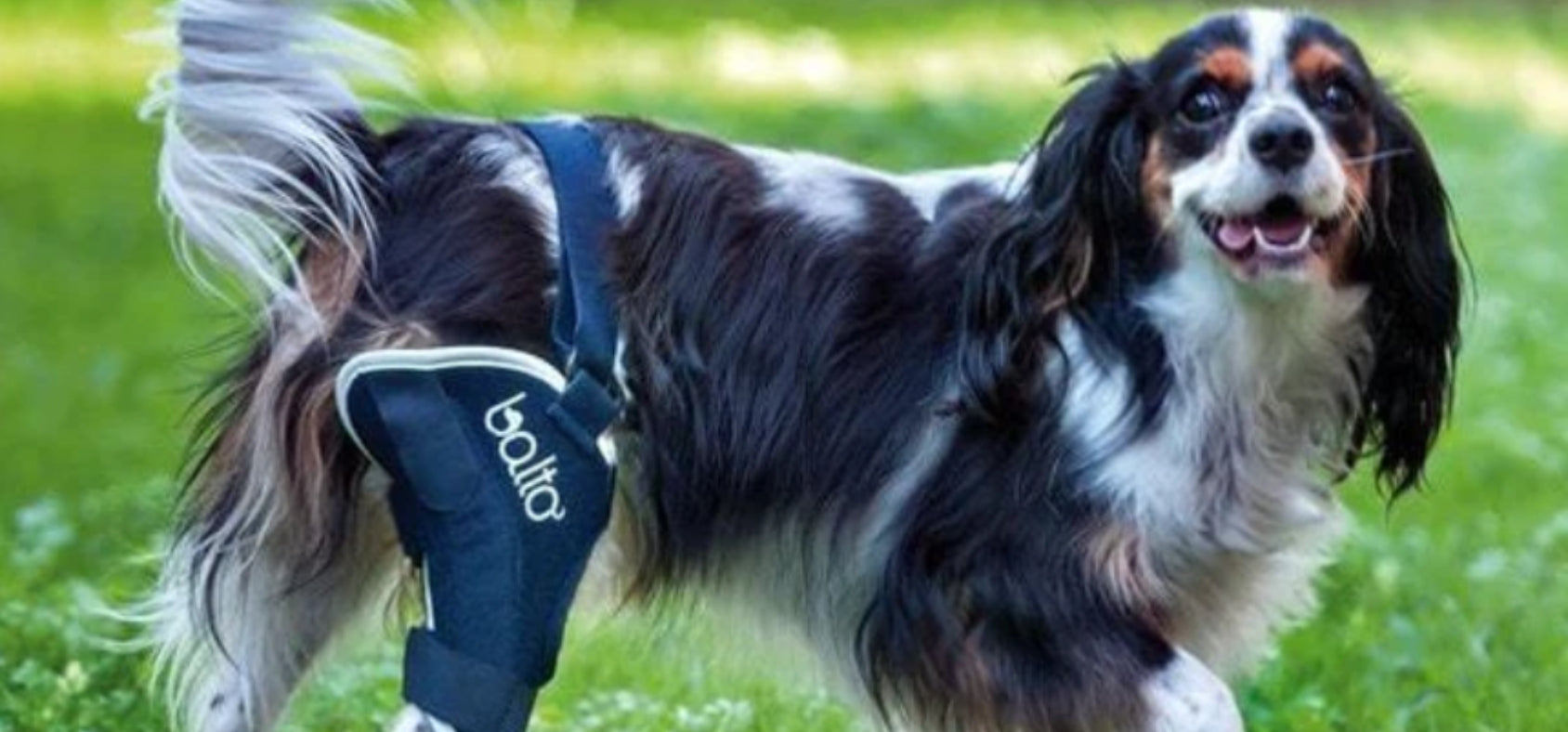I Think My Dog...
Has a Cruciate Ligament Knee Tear or Rupture. What Should I Do?

When your dog is recovering after Cruciate Ligament Surgery, it is important as a dog owner to insure we assist in the rehabilitation as much as possible. This means directly controlling their environment, while rehabilitating the injured leg and surrounding muscles. Directly after surgery it is important your dog has complete rest for the initial six weeks. The easiest way to ensure this rest period is to keep your dog in a smaller space or room to avoid them moving too far. You may let your dog walk on a leash for a few minutes at a time to go to the toilet, but this must only be for a short period to allow maximum healing time. It is important to avoid walking up stairs and walking on smooth surfaces, as your dog may slip causing more strain to the removing limb. If you are worried about your dog slipping, use some of our Power Paws anti slip dogs socks.
There a a few exercises that you can work on with your dog once the bandages have been removed. This will help speed up the recovery as strengthening the muscles helps support the healing. Be consistent with these exercises and allow time for at least a couple of these a day. Here we have listed a few exercises that offer positive results and can be performed by the dog owner at home. Flex and extend each joint on the injured limb a minimum of 10 times. Cycle the injured limb through its full, pain free range-of-motion 10 times. DO NOT FORCE THE JOINTS OR CAUSE PAIN. It is very important that you gently manoeuvre the limb through a range of motion that causes your pet no discomfort. Longer-term follow-up and care There are a number of follow-up and general strengthening exercises that you can perform with your pet after the six-week rest period has expired. It is also highly recommended that you take your pet to receive a radiograph of the previously injured joint to see how the healing is coming along. The exercises are: Controlled leash walks for periods of no longer than 20 minutes twice a day. Sit and stand exercises. These can be done during leash walks simply by commanding your pet to and, just before it assumes the sitting position, the walk- on command is given. This routine should be repeated 10 or more times every walk as it helps build up the rear leg muscles, which is highly important in your pet's rehabilitation. Running and jumping should be avoided until at least week 12 of recovery.
Between weeks 8 and 12: Exercise can be increased slowly to 30-minute to 40-minute sessions. Hydrotherapy is encouraged as its a low impact exercise that offers fantastic results fast, but in a controlled environment. 15 minutes several times a week is advised rather than one longer session. Keep in mind that pets recover at different rates but if your pet is not at near normal activity levels by weeks 12“16 an appointment should be made for reassessment. As a torn Cruciate Ligament is the most common injury in dogs, there is a brace available that will assist and stabilize the joint in the period after the operation.
Offers therapeutic support and stabilization before and after surgery. It is also useful in cases when surgery is not necessary or feasible. Immobilization of the knee and leg promote reduced pain, inflammation and support during healing. In 60% of cases, a dog with a torn ACL will later injure the other knee. It is our hope that by stabilizing the injured knee as well as balancing the back and hip areas of the dog, further injury can be reduced. Our unique and original butterfly design of the back anchor support of the knee brace also lends support to the lower back and hip areas to reduce strain from limping. By stabilizing and balancing the rear end of the dog, it may help prevent injury of the other knee or joints. We designed this brace to fit the natural angle of the knee to prevent it from hyper-flexing while still allowing limited mobility. Flexible metal stays on either side of the knee aid in keeping the knee in it's natural position and foam padding at the knee offers a more cushioned support. The brace allows your canine friend to move easily and without strain on the joint.
Has a Cruciate Ligament Knee Tear or Rupture. What Should I Do?
Is My Dog Too Old For Cruciate Ligament Knee Surgery (TPLO surgery)?
I Don’t Want My Dog To Have Cruciate Ligament Knee Surgery (TPLO Surgery). What Are The Alternative Treatments?
Is Cruciate Ligament Knee Surgery (TPLO Surgery) Successful For Dogs?
Dog Cruciate Ligament Knee Surgery (TPLO Surgery) - What Happens, Is It Successful and What Should I Know?
The Pros and Cons For a Custom Cruciate Ligament Knee Brace For My Dog?
Can My Dog Get Up From The Floor, Sit Down and Squat While Wearing a Knee Brace?
After Cruciate Ligament Knee Surgery (TPLO) - What Is the Recovery Time?
Cruciate Ligament Care for Dogs
Pre & Post Surgery

We can help find the right solution for your dog
Feel free to give us a call on 01730 622544
or email us at woof@zoomadog.co.uk